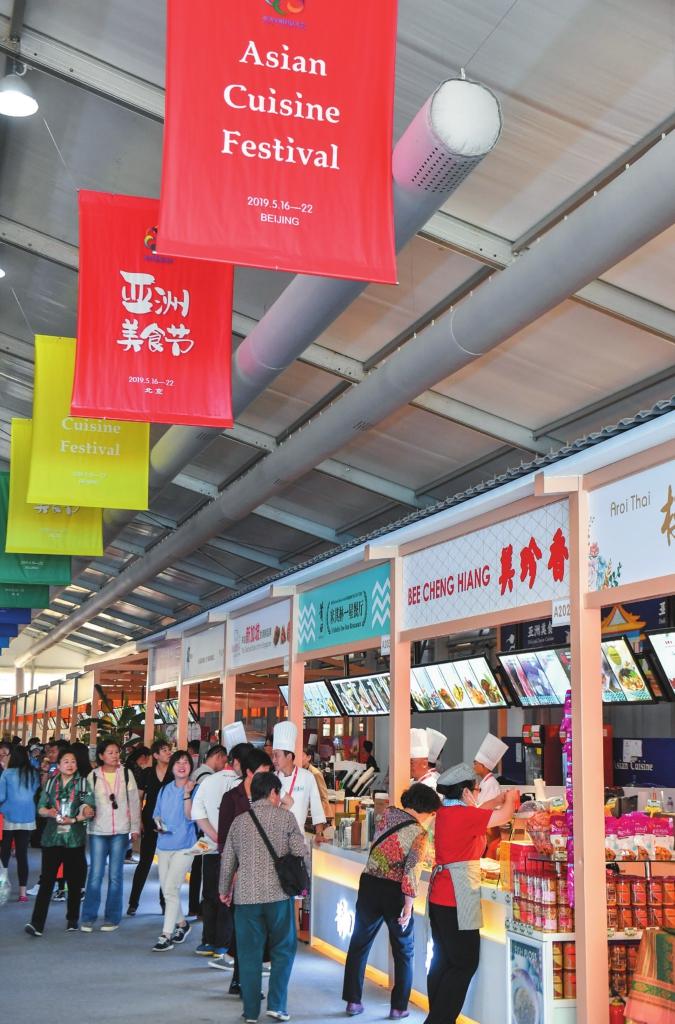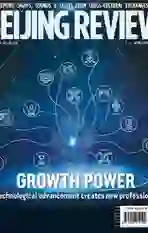A Feast for the Senses
2019-06-03ByJiJing
By Ji Jing


Laksa, a noodle dish popular in Malaysia and Singapore on display at the Asian Cuisine Festival in Beijing in mid-May, epitomizes the infl uence of cultural exchanges: the dish is made with herbs and spices from 36 countries along the ancient Silk Road.
The Asian Cuisine Festival on May 16-22 was literally the most delicious part of the Asian Civilization Week. An important component of the Conference on Dialogue of Asian Civilizations (CDAC), the Asian Civilization Week also consisted of performances, film and TV program screenings, parades and exhibitions, manifesting the brilliant and diversifi ed cultures on the continent.
Culinary delights
Other Asian cuisines have become increasingly popular in China in recent years. According to the 2019 Asian Cuisine Consumption Trends Report published by Meituan-Dianping, Chinas largest on-demand service platform, the number of Asian restaurants in China has kept an annual growth rate of 50 percent. In Beijing alone, there are now more than 4,000 Asian restaurants besides regular Chinese restaurants, according to the Beijing Municipal Bureau of Commerce.
In terms of the number of Asian restaurants in China, the top three are Japanese, Korean and Southeast Asian cuisines, while restaurants of South Asia, West Asia and Central Asia flavors are also rapidly expanding, according to the report. People from Shanghai, Beijing and Guangzhou frequent those Asian restaurants most, while young people born after 1990 account for 54.97 percent of their patrons and those born after 1980 make up 27.46 percent of the total number of customers.
Enjoying local food has become an important component of Chinese tourists to other Asian countries. Thailand, Japan, Indonesia, Viet Nam and the United Arab Emirates occupy the top fi ve spots where Chinese tourists spend on local cuisines.
In addition, Chinese food has gained increasing popularity in other Asian countries. In 2018 the number of Chinese restaurants in Asian countries reached over 44,000, a 120-percent increase from 2015. Over 40 timehonored Chinese restaurant brands such as Quanjude Roast Duck and renowned hotpot restaurant Donglaishun have opened in 21 Asian cities, while modern restaurant chains such as Haidilao Hotpot have set up branches in 17 Asian cities.
“Asia is where multiple cultures and ethnic groups converge. Over 40 countries on the continent have diverse culinary cultures which not only provide rich gourmet experiences for Asian people but also contribute to human culture,” Jiang Junxian, Chairman of the China Cuisine Association (CCA), said at the Asian Cuisine Culture Forum.
According to the Asian Cuisine Development Report jointly released by Global Times newspaper and the CCA at the forum, Chinese cuisine has become one of the most competitive cuisines in Asia, and has gained widespread recognition from customers on the continent.
“Food is a forerunner in communication and integration among countries,” Cai Xiaojun, an offi cial with the Beijing Municipal Bureau of Commerce, said.
Booming tourism
Along with food, tourism also plays a crucial role in cultural exchanges among Asian countries. With its long history and glorious cultures, Asia has abundant tourism resources.
President Xi Jinping highlighted the role of tourism in promoting cultural exchanges and mutual learning in his keynote speech at the opening of the CDAC on May 15, vowing to implement a plan to promote tourism in Asia to boost economic development and deepen friendship among Asians.
The Asian Civilization Week also included the Asian Culture and Tourism Exhibition in Beijing on May 16-18 to showcase the latest tourism achievements in Asia and to promote tourism between China and other Asian countries.
Sushil Kumar Singh, Assistant Director of the India Tourism Office in Beijing under the Ministry of Tourism of India in charge of the India booth at the exhibition, told Beijing Review that China is a very important tourism market for his country. “People are very interested in going to India. They want to learn yoga, which is so popular in China that there are thousands of yoga studios in the country. Indian fi lms are also popular in China.” Last year, Chinese tourists made 247,000 visits to India.
As a whole, Asia is the top tourist destination for Chinese people. In 2018, over 70 percent of Chinese overseas tourist trips were to Asian countries, according to the Asian Tourism Cooperation and Exchanges Report released by the China Tourism Academy (CTA) at the Culture, Tourism and People-to-People Exchange Forum of the CDAC.
The Philippines, with its idyllic tropical islands, is very attractive to Chinese tourists. Last year, they made 1.2 million trips to the country, ranking second in terms of total international tourist arrivals.
Tomasito G. Umali, Tourism Attaché of the Philippine Department of Tourism Beijing Office, said to Beijing Review, “The Philippines and China are ocean neighbors. We have a long history based on artifacts like porcelains found in the Philippines which archaeologists said belonged to Chinas Song Dynasty (960-1279)…Our mission is to make the Philippines known to Chinese people not only as a tourist destination but also as a people and a nation so that more friendship will develop between China and the Philippines.”
The Belt and Road Initiative has helped boost tourism between China and other participating countries. Syed Muhammad Mehdi, Managing Director of the Pakistani company One World which organizes conferences, exhibitions and festivals, said that the infrastructure of Pakistan is growing fast thanks to the initiative. For example, the travel time between capital city Islamabad and the tourist city Gilgit shortened from up to 15 hours six months ago to eight hours today, with the road becoming much safer. As a result, it is expected that more tourists will choose Pakistan. Moreover, Central Asian countries such as Tajikistan and Azerbaijan are attracting more Chinese tourists because of the initiative.
“Most people want to travel abroad to see other cultures and countries. It helps people of different cultures and nationalities to understand and know each other. Certainly it helps intercultural dialogue,” Shashin Shahbazov, Chief Advisor of the Ministry of Culture and Tourism of Azerbaijan, told Beijing Review at the exhibition.
“I think countries in Asia must start opening their borders to each other. We have to solve visa problems among Asian countries. If Asian countries can do things like the European Union, Asia will be stronger,” he added.
Asian countries and regions are also the most important tourism market for China. The number of overnight visits by tourists from other Asian countries to China has maintained an annual average growth rate of 7.2 percent over the past 15 years, reaching 15.09 million in 2017, according to the CTA report.
“The rising tourism between China and Asian countries has increased mutual political trust. Tourism has promoted cultural exchanges and mutual learning among Asian countries and become the public basis for peopleto-people exchanges,” Dai Bin, President of the CTA, said at the forum. “Tourism consumption has boosted social and economic development. The large-scale cross-border consumption has expanded the market in the food, accommodation, transportation, commerce and cultural and leisure sectors of the target countries, which has created jobs and increased local peoples income,” he added.
The report also said the development of tourism in Asia has played an important role in promoting people-to-people exchanges and mutual learning among countries over the past 20 years. Compared with exchanges of technicians and students, tourism has a larger scale, higher frequency, lower threshold and wider coverage, which altogether provide a steady basis for people-to-people bonds.
Other highlights
The Asian Film and TV Week on May 16-23 included a dialogue among fi lm professionals in Asia, a forum for Asian fi lm producers, as well as the screening of fi lms and TV programs.
Held at the Beijing Working Peoples Cultural Palace on May 16, the film dialogue attracted massive participation, including more than 10 iconic figures. Among them were Chinese director Chen Kaige, actress Zhang Ziyi, Indian star Aamir Khan and Oscar-winning Japanese director Yojiro Takita.
During the week, over 60 classic fi lms from more than 30 Asian countries and regions were screened in Beijing, Shanghai, Guangzhou, Chengdu and Xian. They included the 2006 Japanese animated film The Girl Who Leapt Through Time about a high schooler who accidentally acquires the ability of time travel, and the 2018 Turkish drama The Wild Pear Tree, which uses a young mans postgraduate experience to pose thoughtful, engaging questions about life in modern Turkey as well as the rest of the world.
Simultaneously, 100 Asia-themed documentaries, TV dramas, animations, films and reality shows were beamed on multiple channels to showcase the colorful cultures in Asia and represent Asian aspirations for a better life. The programs included the 1993 Vietnamese film The Scent of Green Papaya about a girls observations as a household servant in two different Saigon families during the 1950-60s.
A series of Asian culture conventions which featured concerts, dances and plays were also held in various theaters in Beijing during the week, including Japanese singer Lisa Onos concert at the National Center for the Performing Arts on May 18.
